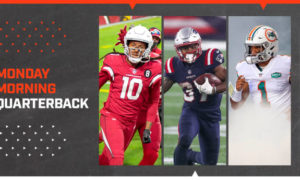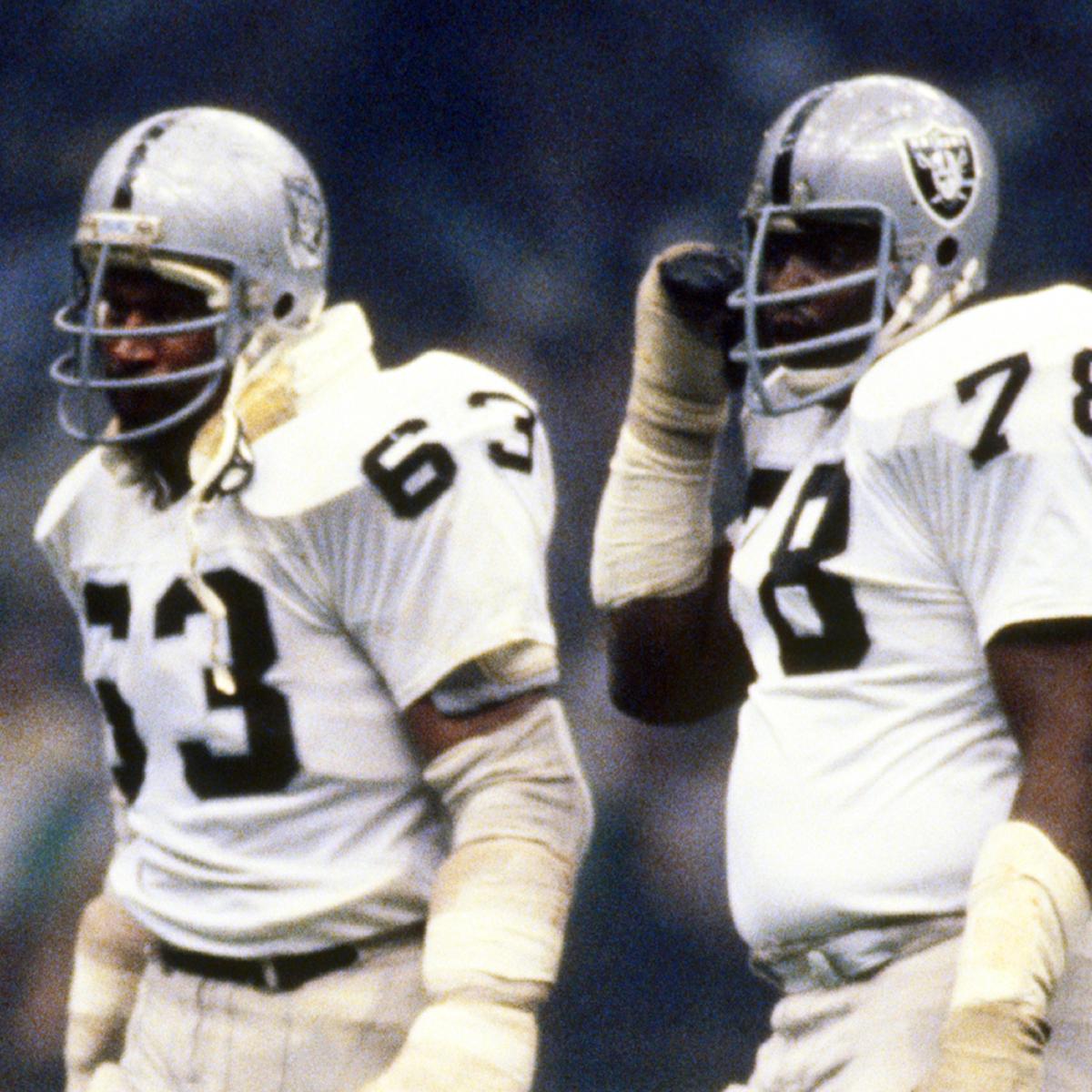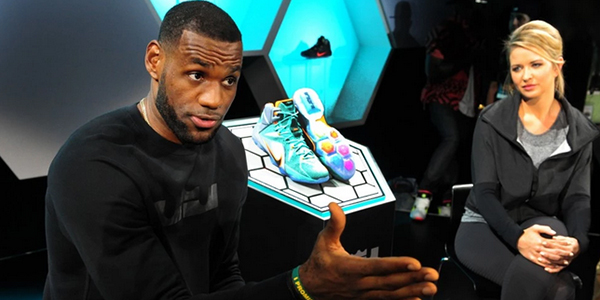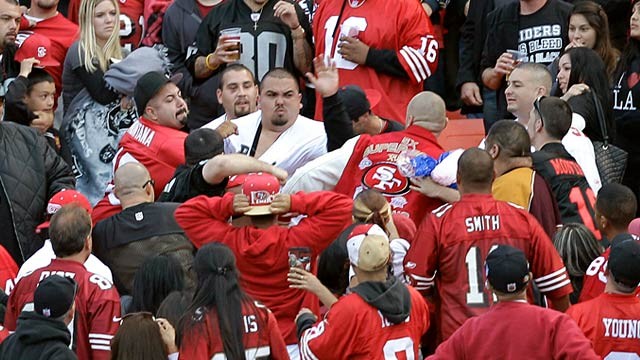Throughout their 100-year history, the Cardinals have seen a lot of standout running backs. Many had short careers but shined very brightly in what time they had. This article will explore the top 10 Cardinals running backs of all time—with a few honorable mentions thrown in for good measure.
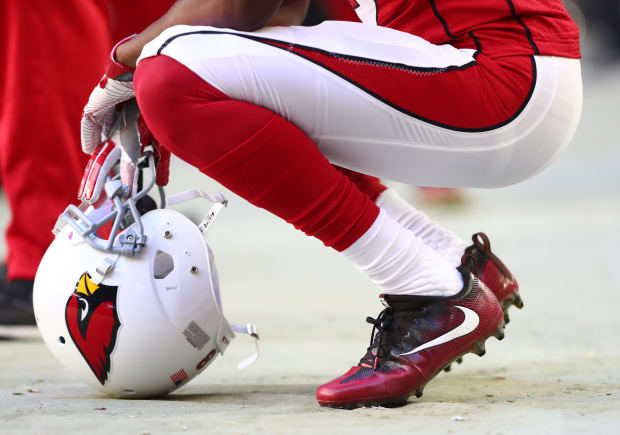
Who Are the Top 10 Cardinals Running Backs of All Time?
The Cardinals have had a strong dose of superior running backs throughout their 100-year history. While the franchise’s location has changed over time (Chicago 1920–59; St. Louis 1960–87; Phoenix 1988–93; and Arizona 1994–present), the Cardinals often had a strong running back in the starting lineup, and the players featured here span nearly the franchise’s entire history. They may not have had the star power of the likes of Jim Brown or Walter Payton, but a handful of Hall of Famers passed through the franchise and several others showed flashes of brilliance in their short careers.
Selection Criteria
Many Cardinals running backs finished with similar career accomplishments, which made creating this list fairly difficult. Nevertheless, what follows is a list of the 10 greatest franchise running backs of all time. Also included is a handful of honorable mentions, as well as statistics from every 1,000-yard rushing season in team history. The criteria used to develop this list include:
- Legacy Honors (Hall of Fame, Ring of Honor, retired number, etc.)
- Single-Season Honors (MVP, All-Pro, Pro Bowl, etc.)
- On-Field Success (League leader, playoff appearances, records, etc.)
- Longevity (Years with the Cardinals, percentage of career with the Cardinals, etc.)
- Versatility (Rushing ability, receiving ability, returning ability, etc.)
Only games played with the Cardinals are factored into this list, so while Hall of Famer Emmitt Smith would be a great player to include on a list about the Cowboys, his two seasons in Arizona with 1,193 yards won’t place him in the top 10 here. You may find my top picks are somewhat controversial, reaching further back in time than most top 10 lists. Did I rank someone higher or lower than you think he deserves? Tell me about it in the comments, below.
10. John David Crow
- Years With the Cardinals: 1958–64
- All-Pro: 1959–60, ’62
- Pro Bowl: 1959–60, ’62
- Legacy Honors: NFL 1960s All-Decade Team
After winning the Heisman Trophy at Texas A&M, John David Crow came to the Cardinals as the second pick in the 1958 NFL Draft. The Cardinals had high expectations for his success, and their confidence was rewarded with seven strong seasons.
By his third season in the league, he became the first running back in franchise history to rush for at least 1,000 yards in a season. His 1,071 yards in 1960 still ranks 10th all-time in Cardinals history, and Crow led the league that season by averaging 5.9 yards per carry.
In 1962, Crow rushed for a career-high 14 touchdowns. Not only did he finish second in the league, he also became the first player in team history to record at least 10 touchdowns in a season—a team record until 2016. Crow missed most of the 1963 season but bounced back nicely in ’64, his final season with the franchise. Over his seven seasons, he carried the ball 787 times for 3,489 yards and 33 touchdowns, while adding 138 receptions for 1,961 yards and 17 touchdowns. He closed out his career with four seasons in San Francisco.
John David Crow: Cardinals Stats
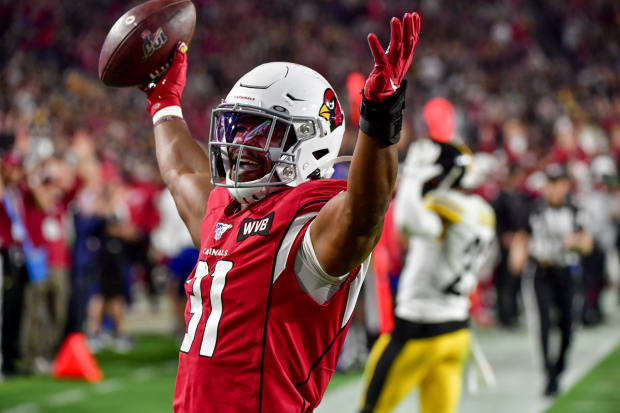
9. David Johnson
- Years With the Cardinals: 2015–19
- Playoff Appearances: 2015
- All-Pro: 2016
- Pro Bowl: 2016
When David Johnson was healthy, he proved to be one of the best running backs in football while with the Cardinals. Multiple health setbacks during his brief career, however, prevented him from showing his true greatness.
Johnson came running out of the gates after being taken as a third-round selection in the 2015 NFL Draft, picking up 1,038 yards from scrimmage as a rookie. He then broke out in a big way during his second season, setting a new franchise record by rushing for 16 touchdowns and leading the NFL with 2,118 yards from scrimmage. He gained at least 100 yards in 15 straight games, tying an NFL record first set by Lions Hall of Famer Barry Sanders.
Johnson was beset by a fractured wrist in the opening game of the 2017 season, but even after missing that entire year he returned to form in ’18 with 1,386 yards from scrimmage. After a lackluster season in 2019, he was traded to the Texans in March ’20. In five seasons, Johnson gained 3,128 yards and 33 touchdowns on 781 carries, while adding 208 receptions for 2,219 yards and 15 touchdowns. He fell just 14 rushing touchdowns short of becoming the all-time franchise career leader.
David Johnson: Cardinals Stats
8. Terry Metcalf
- Years With the Cardinals: 1973–77
- Playoff Appearances: 1974–75
- All-Pro: 1975
- Pro Bowl: 1974–75, ’77
Terrance “Terry” Metcalf was a threat all over the field during his brief but wildly successful career. He spent only five seasons with the Cardinals, but in that time he proved to be a worthy running back, receiver and return specialist.
In 1975, Metcalf established a new NFL record for single-season all-purpose yardage (2,462), which included 960 yards on kick returns and 816 rushing yards. His record stood until 1985 but remains the high mark for a 14-game season. He also gained more than 2,000 all-purpose yards in 1974 and ’77 to become the first player to do so in three seasons.
Metcalf had the rare ability to run with force inside the tackles and run with grace outside of the tackles. What caught up with him, however, was his troubles with fumbles—he twice led the league and dropped the ball at least 10 times in three seasons—and Cardinals fans punished him for it at every turn.
Ultimately, Metcalf’s salary demands were too much for the team’s front office to commit to, which led him to sign a “lifetime” contract with the Toronto Argonauts of the Canadian Football League. Because the field is wider in the CFL, it was thought that Metcalf would become one of that league’s best players, but he never gained more than 700 rushing yards in a season.
Throughout his Cardinals career, Metcalf gained 3,438 yards and 24 touchdowns on 748 carries, while adding 197 receptions for 1,862 yards and nine touchdowns. In the return game, he added another 3,725 yards and three touchdowns.
Terry Metcalf: Cardinals Stats
7. Larry Centers
- Years With the Cardinals: 1990–98
- Playoff Appearances: 1998
- All-Pro: 1996
- Pro Bowl: 1995–96
Larry Centers redefined the fullback position during his time with the Cardinals. Most of his damage, however, came in the receiving game. After being selected in the fifth round of the 1990 NFL Draft, Centers saw sparse playing time over his first three seasons, but his role did increase each season.
It wasn’t until 1994 that he found his niche under a new head coach, and he had his first of three straight seasons with at least 980 yards from scrimmage. In 1995, he became the first running back to catch over 100 passes in a season and held that record (101) until 2014.
When he left the Cardinals after the 1998 season, he had run the ball 517 times for 1,736 yards and 10 touchdowns, while hauling in 535 passes for 4,539 yards and 19 touchdowns. At the time, he held the franchise record for receptions, and he still has the most career receptions in NFL history among running backs.
Larry Centers: Cardinals Stats
6. Elmer Angsman
- Years With the Cardinals: 1946–52
- Playoff Appearances: 1947–48
- Pro Bowl: 1950
The 1947 Cardinals were built to be a championship contender, and Elmer Angsman made sure that became reality when he laced up his spikes for that year’s NFL championship game against the Eagles. Angsman dashed down the field for a pair of 70-yard touchdowns and had 159 yards in the game, leading to a 28–21 victory that still stands as the last championship in Cardinals history. Angsman gained those yards on just 10 carries, and his average of 15.9 yards per attempt still stands as a single-game postseason record among rushers with at least 10 carries.
When he was selected in the third round of the 1946 NFL Draft at 20 years old, Angsman was the youngest player to be drafted into the league. Starting with his second season, he rushed at least 100 times for five straight seasons in a crowded backfield.
Angsman ran for more than 600 yards in both 1948 and ’49, but his production dropped over the next two seasons. He was replaced as a primary rusher in 1952 by rookie Ollie Matson, who was beginning his Hall of Fame career, and Angsman retired after the season.
Throughout his seven seasons, Angsman carried the ball 683 times for 2,908 yards and 27 touchdowns, while adding 41 catches for 654 yards and five touchdowns. He was known as a fearless runner, and according to his obituary, he once finished a game after having eight teeth knocked out.
Elmer Angsman: Cardinals Stats
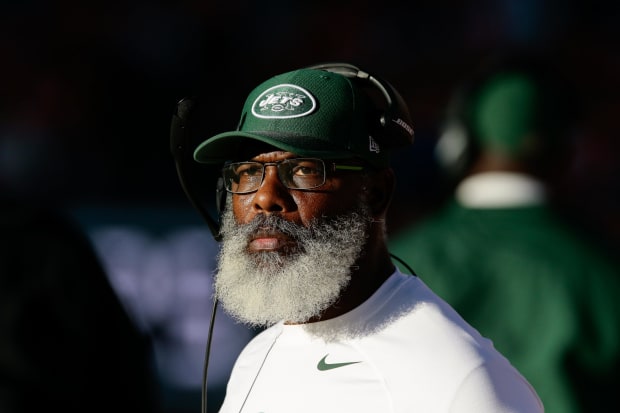
5. Stump Mitchell
- Years With the Cardinals: 1981–89
- Playoff Appearances: 1982
The Cardinals drafted Stump Mitchell as a ninth-round selection in the 1981 NFL Draft, and they got much more out of that investment than they could have expected. Mitchell developed into a well-rounded football player who left the Cardinals as the franchise’s all-time leader in all-purpose yardage.
Out of the gates as a rookie, Mitchell was an electrifying kick returner. He later developed into a fierce straight-line runner and eventually embodied the heart and soul of the franchise. Then, in one violent collision with the Giants’ defense—everything was over. In Week 3 of the 1989 season, Mitchell took a vicious blow to his left knee that ended his season, and the Cardinals released him before the ’90 campaign began.
As a rookie, Mitchell led the NFL with 1,292 kick return yards. His primary role continued to be as a punt and kick returner through the 1984 season, though he did have a career-high 11 offensive touchdowns in ’84. A year later, he broke out as a rusher, gaining more than 1,000 yards for the only time in his career.
He’d have at least 900 yards from scrimmage each of the next three seasons, and he was on pace for another strong year in 1989. By the end of his career, he had carried the ball 986 times for 4,649 yards and 32 touchdowns, and also had 209 receptions for 1,955 yards and nine touchdowns. In the return game, he gained 5,384 yards and had another touchdown.
Stump Mitchell: Cardinals Stats
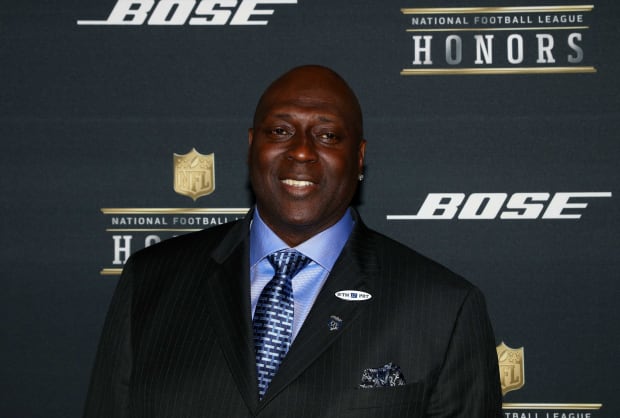
4. Ottis Anderson
- Years With the Cardinals: 1979–86
- Playoff Appearances: 1982
- All-Pro: 1979
- Pro Bowl: 1979–80
- Major Awards: Offensive Rookie of the Year (1979)
Statistically, Ottis Anderson owns multiple records for the Cardinals, and he deserves mention among the greatest running backs in franchise history. The team’s all-time leading career rusher (7,999 yards and 46 touchdowns), as well as the owner of Arizona’s top-four single-season rushing efforts, Anderson carved out a place in Cardinals history before making plays in the Super Bowl for the Giants.
He burst onto the scene with one of the finest running back rookie seasons ever, obliterating the franchise record for single-season rushing (Anderson’s 1,605 easily bested Jim Otis’s 1,076 yards from 1976). This record has yet to be broken. Anderson ran for 193 yards in his debut, falling two yards shy of breaking an NFL record and setting a career high that he’d never surpass. It was also the first of 34 games with the Cardinals in which he’d run for at least 100 yards.
Anderson rushed for more than 1,000 yards and had more than 1,600 yards of offense in five of his first six seasons. The lone exception came during the strike-shortened 1982 season, when he was on pace to easily do so again had the league played 16 games. He missed half of the 1985 season, however, opening the door for Stump Mitchell to snatch the role of primary ball carrier.
A month into the 1986 season, Anderson was traded to the Giants, where he would eventually be rejuvenated and win a Super Bowl MVP trophy. And while that is what most fans generally remember him for, it was his years with the Cardinals that were his best. He racked up those 7,999 yards and 46 touchdowns on 1,858 carries—all franchise career records—while also adding 299 receptions for 2,495 yards and five touchdowns.
Ottis Anderson: Cardinals Stats
3. Ernie Nevers
- Years With the Cardinals: 1929–31
- All-Pro: 1929–31
- Legacy Honors: Hall of Fame (1963), Cardinals Ring of Honor, NFL 1920s All-Decade Team
Ernest “Ernie” Nevers played in a different era of the NFL, and as such, he was much more than a running back. That versatility placed him among the greatest football players of his time, but he had three seasons with the Cardinals that brought plenty of excitement to the budding franchise.
While playing with the Duluth Eskimos in 1926 and ’27, Nevers also took a shot at a career in Major League Baseball with the St. Louis Browns (1926–28). He’d ultimately return to the NFL in 1929 with the Cardinals, and throughout the season he often scored all of the team’s points since he doubled as the kicker. That included the legendary game on Nov. 28, 1929, when he scored all 40 of the Cardinals’ points against the Bears—setting an NFL record that likely will never be broken.
Nevers was selected as a first-team All-Pro at fullback each season with the Cardinals, and he also doubled as head coach in 1930 and ’31. In the last game of his career, he had two rushing touchdowns for a 21–0 victory over the Cleveland Indians, helping finish his Cardinals career with 199 points. In 1931, he was tied for second in a one-off vote of the greatest football player of all time. He was injured during a charity game in 1932 and retired before the NFL season began. In 1963, he was inducted as a charter member of the Hall of Fame.
Ernie Nevers: Cardinals Stats
2. Ollie Matson
- Years With the Cardinals: 1952, 1954–58
- All-Pro: 1952, 1954–57
- Pro Bowl: 1952, 1954–58
- Awards: Co-Rookie of the Year (1952)
- Legacy Honors: Hall of Fame (1972), Cardinals Ring of Honor, NFL 1950s All-Decade Team
No one questioned Ollie Matson’s speed when he was taken with the third selection in the 1952 NFL Draft. After leading the nation in yards as a senior in college, no one doubted his football skills, either.
As a star in two sports, Matson came to the Cardinals the same year he won a pair of track and field Olympic medals in Helsinki. His blazing speed was on full display during his first season, when he shared Rookie of the Year honors with Hugh Elhenney of the 49ers. Just four years removed from back-to-back appearances in the NFL championship game, the Cardinals were looking to Matson to bring them back to relevance after a 3–9 finish in 1951.
Matson—who did not play in 1953 because he served in the Army—did his part every season for the Cardinals. However, the team had just one winning season during his tenure (a 7–5 finish in 1956). Matson never rushed for 1,000 yards in any season, but because he was so adept at catching passes, he was able to surpass 1,000 yards of offense in half of his six seasons with the Cardinals. His 924 yards in 1956 briefly stood as a single-season franchise record.
Then, in a famed trade before the 1959 season, Matson was sent to the Rams in exchange for eight players and one draft pick. That left Matson with 761 rushing attempts for 3,331 yards and 24 touchdowns, as well as 130 catches for 2,150 yards and another 16 touchdowns in his time with the Cardinals.
Ollie Matson: Cardinals Stats
1. Charley Trippi
- Years With the Cardinals: 1947–55
- Playoff Appearances: 1947–48
- All-Pro: 1948
- Pro Bowl: 1952–53
- Legacy Honors: Hall of Fame (1968), Cardinals Ring of Honor, NFL 1940s All-Decade Team
There’s no doubt that Charley Trippi was a solid receiver, quarterback, punter, returner and defender, but I also believe he was the greatest running back ever to suit up for the Cardinals. Trippi was the final piece of the “Million Dollar Backfield” that helped the Cardinals claim the 1947 NFL championship and make another appearance in the ’48 title game. He is also the only player in the Hall of Fame with at least 1,000 career rushing, receiving and passing yards.
Trippi was courted by numerous teams—both in football and baseball—and he nearly signed a dual-sport contract with the New York Yankees of the budding All-America Football Conference and the New York Yankees of MLB. But long-time Cardinals owner Charles Bidwell presented a four-year offer worth $100,000 that lured Trippi to the NFL and paid dividends for the franchise.
Trippi had 206 all-purpose yards and two touchdowns as the Cardinals defeated the Eagles for the 1947 NFL championship, and he then led the NFL in all-purpose yards the next two seasons.
By 1951, Trippi began to show just how versatile he was. In 1951 and ’52, he served as the Cardinals quarterback but still ran the ball regularly—gaining a combined 851 yards and eight touchdowns on the ground those seasons. He returned to running back in 1953, when he oddly did not score a rushing touchdown, and then he became a defensive back for the ’54 season. He also served as the primary punter in both of those seasons.
A preseason injury in 1955 limited his playing time that season and ultimately ended his career. His rushing totals showed 687 carries for 3,506 yards and 23 touchdowns. Additional stats from his career included:
- Receiving: 130 catches for 1,321 yards and 11 touchdowns
- Passing: 205 of 434 for 2,547 yards and 16 touchdowns
- Punting: 196 punts at an average of 40.3 yards per punt
- Return man: 2,321 yards
- Defense: 4 interceptions, including a touchdown as a rookie
At age 98, Trippi is the oldest living member of the Hall of Fame and one of the oldest living professional football players.
Charley Trippi: Cardinals Stats
Honorable Mentions
The following running backs left an indelible mark on Cardinals history but didn’t quite make the top 10.
Johnny Roland (1966–72)
Johnny Roland retired as the leading rusher in franchise history after a seven-year career with the Cardinals. In 1966, United Press International named him Rookie of the Year (the Associated Press began handing out its prestigious Rookie of the Year award in 1967), and he made his first of two Pro Bowls. Roland posted career highs with 876 rushing yards and 11 offensive touchdowns in 1967. When his tenure with the Cardinals ended, he had gained 3,608 yards and 27 touchdowns on 962 carries, while adding 1,240 yards and five touchdowns on 131 receptions.
Jim Otis (1973–78)
Jim Otis played the final six seasons of his career with the Cardinals, and he brought them plenty of production in 1975. That year, he made his only Pro Bowl after rushing for 1,076 yards to narrowly lead the NFC in rushing yards. Otis finished his career with the Cardinals with 1,011 carries for 3,863 yards and 19 touchdowns.
Pat Harder (1946–50)
Pat Harder was the league’s leading scorer from 1947 to ’49, when he doubled as a member of the “Million Dollar Backfield” and was the Cardinals’ primary kicker. His efforts in 1948 landed him the league’s MVP trophy, and he was also a first-team All-Pro from ’47 to ’49. He rushed 550 times for 2,371 yards and 25 touchdowns.
Marshall Goldberg (1939–43, 1946–48)
Though he is most known for his offensive exploits at the University of Pittsburgh, Marshall Goldberg did his fair share of damage for the Cardinals, too. He ultimately became a standout defensive player in the NFL, but he also helped on the offensive end in the early years of his career. Two years of his career were lost to military service, but he carried the ball 476 times for 1,644 yards and 11 touchdowns, while also catching 60 passes for 775 yards and five touchdowns. Defensively, he had a decisive interception during the 1947 NFL championship game, which the Cardinals won over the Eagles, 28–21.
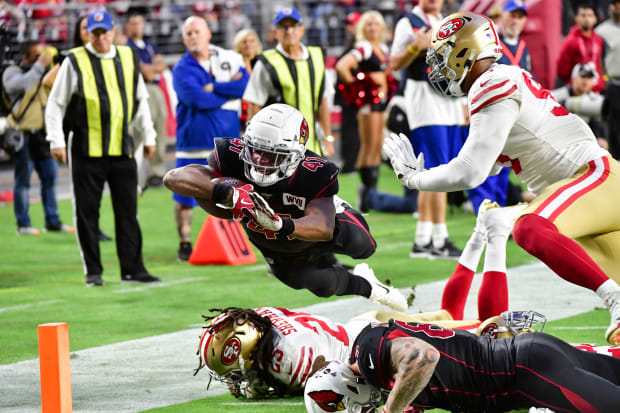
Cardinals Running Back Facts and Trivia
The Cardinals have had 41 players throughout their 100-year history rush for at least 10 touchdowns in their career, and they’ve had 20 players who have rushed for at least 2,000 career yards. A handful of other facts and trivia about Cardinals running backs follow.
What was the “Million Dollar Backfield?”
Cardinals owner Charles Bidwell desperately wanted an NFL championship after having nothing to show off after owning the team for 14 seasons. He figured that bolstering his offense with some of the best rushing talent would be a good starting point, so he strategically drafted a few players and then handed out a lucrative contract to create the “Million Dollar Backfield.”
In 1945, Jimmy Conzelman was hired as head coach of the Cardinals, and he implemented the run-heavy “T” formation on offense. That same year, he drafted quarterback Paul Christman to manage the offense, and he added fullback Pat Harder and halfback Elmer Angsman to the picture in 1946. At the same time, the All-America Football Conference was established as a competitor to the NFL, and the new Chicago Rockets left the city with three professional football teams. Bidwell vowed that his Cardinals wouldn’t be the worst of the bunch, and he promptly outbid the Rockets in 1947 for the services of running Charley Trippi. Trippi was given an unprecedented four-year, $100,000 contract to come to the Cardinals and complete the “Million Dollar Backfield.”
Bidwell, however, would never see the fruits of his investment; he died shortly after signing Trippi. The Cardinals became one of the best teams in the league in 1947, beating the Bears in the season finale to finish the regular season at 9–3 and advance to the NFL championship game.
In that meeting with the Eagles, Trippi opened the scoring with a 44-yard run in the first quarter, and Angsman scored on a pair of 70-yard dashes. Trippi added a punt return for a touchdown, and Harder got in the mix with four extra-point kicks in Chicago’s 28–21 victory that remains the franchise’s last championship. The teams had a rematch for the 1948 title, but extremely snowy conditions left a low-scoring 7–0 win for the Eagles in the first televised NFL championship game.
How many Cardinals running backs have rushed for 1,000 yards in a season?
The Cardinals have 10 players who have rushed for at least 1,000 yards in a season. Ottis Anderson had the most, recording five such seasons.
Who is the current starting running back for Arizona?
The incumbent starting running back for the Cardinals, David Johnson, was traded in the offseason. Kenyan Drake became the starter for 2020. The Cardinals also selected Eno Benjamin in the seventh round of the 2020 NFL Draft, and they have high hopes for him moving forward.
What is the longest rushing play in Cardinals history?
John David Crow scored on an 83-yard touchdown run on Oct. 4, 1958, which is the longest rushing play in Cardinals history. Ollie Matson holds the record for the longest non-scoring rushing play, scampering 79 yards twice in his career without reaching the end zone.
How many running backs have the Cardinals drafted in the first round?
The Cardinals have selected 21 running backs in the first round of the NFL draft.
- 2009: Beanie Wells (No. 31)
- 2000: Thomas Jones (No. 7)
- 1993: Garrison Hearst (No. 3)
- 1979: Ottis Anderson (No. 8)
- 1970: Larry Stegent (No. 8)
- 1968: MacArthur Lane (No. 13)
- 1958: John David Crow (No. 2)
- 1956: Joe Childress (No. 7)
- 1953: Johnny Olszewski (No. 4)
- 1952: Ollie Matson (No. 3)
- 1948: Jim Spavital (No. 11)
- 1946: Dub Jones (No. 2)
- 1945: Charley Trippi (No. 1)
- 1944: Pat Harder (No. 2)
- 1943: Glenn Dobbs (No. 3)
- 1942: Steve Lach (No. 4)
- 1941: John Kimbrough (No. 2)
- 1940: George Cafego (No. 1)
- 1938: Jack Robbins (No. 5)
- 1937: Ray Buivid (No. 3)
- 1936: Jimmy Lawrence (No. 5)
Cardinals Rushing Records
Listed below are the franchise’s rushing records, as well as a list of every 1,000-yard rushing season in team history.
- Career Yards: 7,999, Ottis Anderson (1979–86)
- Single-Season Yards: 1,605, Anderson (1979)
- Single-Game Yards: 228, Beanie Wells (Nov. 27, 2011)
- Single-Season Touchdowns: 16, David Johnson (2016)
- Career Touchdowns: 46, Anderson (1979–86)
- Single-Game Touchdowns: 6, Ernie Nevers (Nov. 28, 1929)*
- Career Rushing Average: 5.1 yards per carry, Charley Trippi (1947–55) (min. 500 att.)
- Single-Season Rushing Average: 5.9 yards per carry, John David Crow (1960) (min. 100 att.)
- Single-Game Rushing Average: 13.0 yards per carry, Trippi (Sept. 26, 1949) (min. 10 att.)
*Tied for the NFL record
Cardinals Running Backs to Rush for 1,000 Yards
——————-
Did you miss our previous article…
https://sportsgooru.com/nfl/the-seahawks-know-you-want-them-to-let-russell-wilson-cook/



